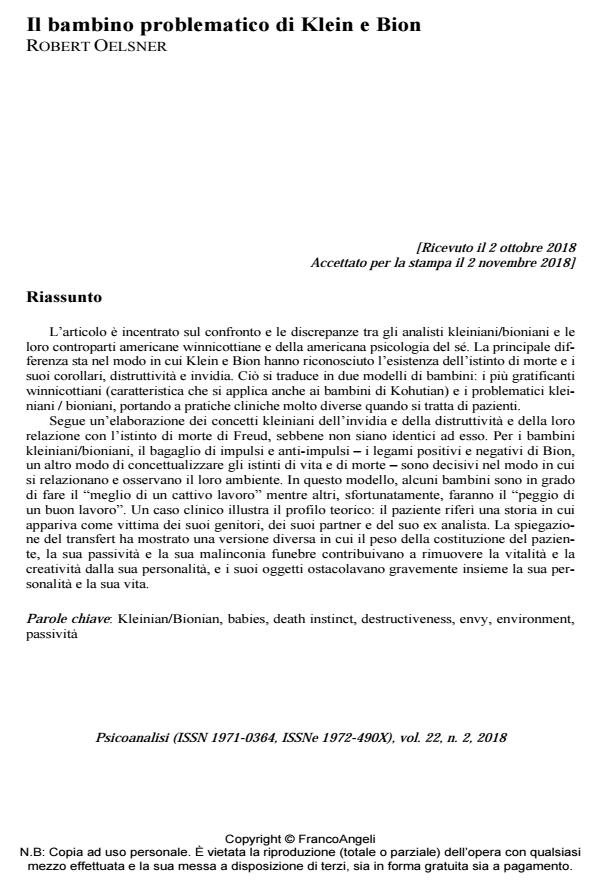Il bambino problematico di Klein e Bion
Titolo Rivista PSICOANALISI
Autori/Curatori Robert Oelsner
Anno di pubblicazione 2019 Fascicolo 2018/2
Lingua Italiano Numero pagine 18 P. 5-22 Dimensione file 187 KB
DOI 10.3280/PSI2018-002001
Il DOI è il codice a barre della proprietà intellettuale: per saperne di più
clicca qui
Qui sotto puoi vedere in anteprima la prima pagina di questo articolo.
Se questo articolo ti interessa, lo puoi acquistare (e scaricare in formato pdf) seguendo le facili indicazioni per acquistare il download credit. Acquista Download Credits per scaricare questo Articolo in formato PDF

FrancoAngeli è membro della Publishers International Linking Association, Inc (PILA)associazione indipendente e non profit per facilitare (attraverso i servizi tecnologici implementati da CrossRef.org) l’accesso degli studiosi ai contenuti digitali nelle pubblicazioni professionali e scientifiche
L’articolo è incentrato sul confronto e le discrepanze tra gli analisti kleiniani/bioniani e le loro controparti americane winnicottiane e della americana psicologia del sé. La principale dif-ferenza sta nel modo in cui Klein e Bion hanno riconosciuto l’esistenza dell’istinto di morte e i suoi corollari, distruttività e invidia. Ciò si traduce in due modelli di bambini: i più gratificanti winnicottiani (caratteristica che si applica anche ai bambini di Kohutian) e i problematici klei-niani / bioniani, portando a pratiche cliniche molto diverse quando si tratta di pazienti. Segue un’elaborazione dei concetti kleiniani dell’invidia e della distruttività e della loro relazione con l’istinto di morte di Freud, sebbene non siano identici ad esso. Per i bambini kleiniani/bioniani, il bagaglio di impulsi e anti-impulsi - i legami positivi e negativi di Bion, un altro modo di concettualizzare gli istinti di vita e di morte - sono decisivi nel modo in cui si relazionano e osservano il loro ambiente. In questo modello, alcuni bambini sono in grado di fare il "meglio di un cattivo lavoro" mentre altri, sfortunatamente, faranno il "peggio di un buon lavoro". Un caso clinico illustra il profilo teorico: il paziente riferì una storia in cui appariva come vittima dei suoi genitori, dei suoi partner e del suo ex analista. La spiegazione del transfert ha mostrato una versione diversa in cui il peso della costituzione del paziente, la sua passività e la sua malinconia funebre contribuivano a rimuovere la vitalità e la creatività dalla sua personalità, e i suoi oggetti ostacolavano gravemente insieme la sua personalità e la sua vita.
Parole chiave:Kleinian/Bionian, babies, death instinct, destructiveness, envy, environment, passività
- Bianchedi E. et al. (1984). Beyond Freudian metapsychology. The metapsychological points of view of the Kleinian school. International Journal of Psychoanalysis, 65: 389-398.
- Bion W.R. (1957). Development of Schizophrenic Thought. In: Second Thoughts. London: Heinemann (trad. it. Lo sviluppo del pensiero schizofrenico. In: Riflettendoci meglio. Roma: Astrolabio, 2016).
- Bion W.R. (undated). How to keep awake. In: Cogitations. London: Karnac Books (trad. it. Come restare svegli. In: Pensieri. Roma: Armando, 2010).
- Britton R. (2005). Comment during the E.B.O.R. Conference in Seattle, October 2005.
- Feldman M. (1997). The Dynamics of Reassurance. In: Schafer R., ed., The Contemporary Kleinians of London. London: IUP, pp. 321-343.
- Freud S. (1915). Triebe und Triebschicksale (trad. it. Pulsioni e loro destini. In: Opere, vol. 8. Torino: Boringhieri, 1976).
- Freud S (1915-177). Vorlesungen zur Einführung in die Psychoanalyse (trad. it. Introduzione alla psicoanalisi. In: Opere, vol. 8. Torino: Boringhieri, 1976).
- Freud S. (1920). Jenseits des Lustprinzips (trad. it. Al di là del principio di piacere. In: Opere, vol. 9. Torino: Boringhieri, 1977).
- Freud S. (1924). Das ökonomische Problem des Masochismus (trad. it. Il problema economico del masochismo. In: Opere, vol. 10. Torino: Boringhieri, 1978).
- Freud S. (1926). Hemmung, Symptom und Angst (trad. it. Inibizione, sintomo e angoscia. In: Opere, vol. 10. Torino: Boringhieri, 1978).
- Green A. (2005). The illusion of common ground and mythical pluralism. International Journal of Psychoanalysis, 86: 627-632.
- Grotstein J. (2007) A beam of intense darkness. London: Karnac Books (trad. it. Un raggio di intense oscurità: l’eredità di Wilfred Bion. Milano: R. Cortina, 2010).
- Isaacs-Elmhirst S. (1980). Bion and Babies. In: Grotstein J. (ed.), Do I dare disturb the Universe? London: Karnak Books, 1988).
- Kafka F. (1924). A hunger artist. In: Glatzer N.N., ed., Franz Kafka. The Complete Stories. New York: Schocken Books (trad. it. L’artista digiunatore. In: Racconti. Milano: Mondadori, 1987).
- Klein M (1930). The Importance of Symbol-Formation in the Development of the Ego. In: Contributions to Psycho-Analysis, 1921-1945. London: The Hogarth press (trad. it. L’importanza della formazione dei simboli nello sviluppo dell’Io. In: Scritti, 1921-1958. Torino: Bollati Boringhieri, 1978).
- Meltzer D. (1973). Sexual States of Mind. Strath Tay, Scotland: Clunie Press (trad. it. Stati sessuali della mente. Roma: Armando, 1983).
- Ogden T. (2004). On holding and containing, being and dreaming. International Journal of Psychoanalysis, 85:1349-64. DOI: 10.1516/0020757042684078
- Rustin M. (1991). The good society and the inner world: psychoanalysis, politics and culture. London, New York: Verso (trad. it. La società buona e il mondo interno. Roma: Borla, 1984).
- Segal H. (1987). Silence is the Real Crime. International Review of Psychoanalysis, 14: 3-12.
- Segal H. (1993). On the clinical usefulness of the concept of the death instinct. International Journal of Psychoanalysis, 74: 55-61.
- Segal H. (2003). The mind of the fundamentalist/terrorist, The Institute of Psychoanalysis. News and Events Annual Issue 2003. Nicola Abel-Hirsch ed.
- Segal H. (2006). Reflections on Truth and Tradition. American Imago, 63, 3: 283-292.
- Spillius E.B. (1993). Varieties of Envious Experience. International Journal of Psychoanalysis, 74: 1199-1212.
- Steiner J. (1993). Psychic Retreats. London: Routledge (trad. it. I rifugi della mente. Torino: Bollati Boringhieri, 1996).
- Wallerstein R.S. (1988). One psychoanalysis or many? International Journal of Psychoanalysis, 69: 5-21.
- Wallerstein R.S. (2005). Will psychoanalytic pluralism be an enduring state of our discipline? International Journal of Psychoanalysis, 86: 623-626. DOI: 10.1516/VJHB-7R8A-162R-B5W
- Winnicott D.W. (1955). Metapsychological and clinical aspects of regression within the psycho-analytical set-up. International Journal of Psychoanalysis, 36: 16-26
Robert Oelsner, Il bambino problematico di Klein e Bion in "PSICOANALISI" 2/2018, pp 5-22, DOI: 10.3280/PSI2018-002001